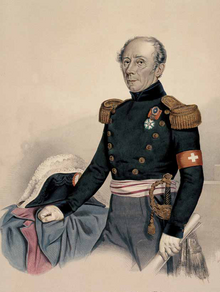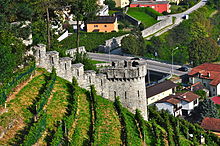Dufour fortifications
Dufour fortifications ( french Fortifications Dufour ) of the Swiss army are mainly border fortifications in the fortress areas Saint-Maurice and Sargans and the fortification of Bellinzona . They form the beginnings of federal fortress construction and are named after their fortress planner, later General Guillaume Henri Dufour . The Dufour fortifications are considered to be military-historical monuments of national importance.
history
Dufour had experience building fortifications in Corfu and Lyon . In 1819 he was involved in founding the first federal military school in Thun , where he taught as chief instructor of genius until 1831 . In 1832 he became the chief quartermaster of the military supervisory authority (until 1847) and "Directeur de la Carte" (until 1865).
On the basis of his work De la fortification permanente , published in 1822 , he was commissioned by the Diet in 1830 to plan the first nationwide fortress system. He created a basic concept for two fortress systems in order to be able to protect Switzerland from foreign invasions: On the one hand, it intended to block the major through axes : the Simplon axis France-Italy at Saint-Maurice and Gondo and the axis South Germany-Italy at Luziensteig and Landquart ( Tardis Bridge ). On the other hand, it aimed to prevent the occupation of the national territory by strengthening the western front at the bridgeheads Aarberg and Solothurn , on the Zihl Canal and the city of Basel .
Political events in neighboring countries prompted the assembly to approve loans for the practical implementation of the most urgent border fortifications, largely according to Dufour's plans: The July Revolution of 1830 in France led to the construction of four entrenchments with 30 guns near Aarberg (Schanzen von Bargen) in 1831 to expand the narrow areas of Saint-Maurice and Gondo, to rebuild St. Luzisteig , to strengthen the area around the Zihl and Basel. After the surveys in Northern Italy in 1848, Saint-Maurice and Sankt Luzisteig were further expanded and the Fortini della Fame was built south of Bellinzona . In 1856, the Neuchâtel trade initiated fortification work on the Rhine and Lake Constance borders. The Italian war of unification of 1859 led to reinforcements in Gondo and Saint-Maurice.
Dufour has summarized his more than thirty years of experience as a planner, builder and perfecter of the most important fortifications in Switzerland as follows:
“ Our neutrality will not be violated on the basis of a secondary interest if our determination to defend it is clearly evident. And nothing in this context proves our intention better than the construction of a few defensive works. "
Fortification Arzillier
In 1831, according to Dufour's concept, the strengthening of the Saint-Maurice barrier at the narrowest point of the Rhone Gorge at Saint-Maurice Castle was started in order to block the passage to the Great St. Bernhard and Simplon Pass . The bridge at the castle over the Rhone, first mentioned in the 12th century, was the first upstream after Lake Geneva . The garrison was manned by 1,800 men and had 50 guns: 13 howitzers and 37 cannons.
The Arzillier fortification was built on the right bank of the Rhone (canton Vaud) . This consisted of the batteries:
- Rhône : three guns in the direction of Bex and three in the direction of the Strait of Monthey , reinforced in 1848, destroyed in 1959 ⊙
- Petite Tenaille : two guns controlled the Bex Strait above the Rhône battery ; in 1859 eight guns were added. ⊙
- Grande Tenaille : the main structure, a bastion in the shape of an irregular hexagon on the slope, was reinforced in 1859 with a moat with a wall. They had to stop an attack from the plateau of Chiètres and cover the bridgehead. ⊙
- Arzillier : two artillery pieces covered the road between Saint-Maurice and the bridge ⊙
- Capucins : served as a reinforcement of the Arzillier battery with the same aim ⊙
The fortification of Arzillier was completed in 1848 and 1859 with the following batteries and a redoubt:
- Gautier ⊙
- Front Lavey : two batteries with two and three guns ⊙
- Redoute de la Crête : had to watch over the plateau of Chiètres ⊙
Saint-Maurice Castle
On the left bank of the Rhone (Canton Valais), the Saint-Maurice Castle was integrated into the fortification system of the Dufour Gorge to defend the Great St. Bernhard and Simplon axis.
The following battery was built near the castle in 1831
- Château : two batteries with three guns each secured the road axis of Monthey ⊙
and on a strip of grass halfway up the «Les Fingles» rock face above Saint-Maurice Abbey, the battery:
- Wielandy : three guns had to cover the Lavey zone up to the bridge. ⊙
and above the lock the following fixings:
- Dufour Tower : A third floor was added in 1848, had to cover and flank the two bridgeheads. ⊙
- Redoute Vérrossaz : Infantry work as an irregular hexagon ⊙
More batteries were added in 1848:
- Saint-Martin : three guns on the hill of the same name towards Monthey. ⊙
- Clocher : three guns on the same strip of grass as the Wielandy battery.
- One of the Château batteries had to give way to the railway tunnel in 1855, which was provided with an explosive object.
When the bullets filled with melinite explosives appeared in 1885, the Dufour fortifications built in 1831 in front of St-Maurice proved to be out of date and had to be replaced. From 1892, the fortress area of Saint-Maurice was expanded primarily with the artillery works Savatan-Dailly-Aiguille ⊙ as well as Cindey ⊙ and Fort du Scex ⊙ .
Tour of the Dufour fortifications
The Dufour fortifications (Fortifications Dufour) on the right bank of the Rhone (Fortifications de l'Arziller, municipality of Bex ) can be visited on a one-hour tour from Saint-Maurice Castle. ⊙
Fortini della Fame
In 1853 the young federal state of Switzerland had a fortification line designed by Dufour, the Fortini della Fame , built south of Bellinzona from Camorino to Sementina and Monte Carasso . Five of the round towers typical of Dufour are still preserved in Camorino.
St. Luzisteig fortress
After Dufour declared Luzisteig among other fortresses as an urgent task in his report of 1831, the old bastion front from the 18th century as the center of the fortress was rebuilt and rebuilt by a Bernese sappers company under the Chur captain of genius and engineer Richard La Nicca a new fortress was built on the St. Luziensteig. A lunette (throat front barracks) with a front facing Maienfeld was created to cover the back . The fortress had 16 guns.
In the 1850s, the log houses were built on the Fläscherberg under the direction of Dufour to prevent bypassing the left flank. During the Crimean War , a rifle tower ("Gusha" or "Hunger tower") was built near the Gusha battery, including a barrier wall through the Gushawald. Due to its elevated position, the «Guschaturm» allowed long-distance reconnaissance.
Fort Gondo
The Fort Gondo blocked the only possible passage ( passage obligé ) of the Simplon Pass road in the throat ( "Casermetta", "Fort Gondo") at 1,067 m above sea level. M. above the mountain village of Gondo . Due to its location, it was not possible to bypass the fortress, as the gorge drops almost vertically for a few 100 meters at this point.
In the Gondo Gorge a crenellated wall was built in 1815 on the right bank of the Doveria mountain stream in order to be able to set fire to the Simplon road on the left. From 1831, Gondo was expanded and strengthened in stages.
See also
- Swiss Dufour Museum in the Artilleriewerk_Halsegg
literature
- Guillaume Henri Dufour: Mémorial pour les travaux de guerre . JJ Paschoud, Geneva and Paris, 1820. Dufour's first independent publication. A teaching and manual about the construction of field fortifications, which served as a teaching aid in the military school in Thun. It received international attention, was translated into several languages and established Dufour's importance as a military educator.
German edition: The manual for practical work in the field for use by officers of all weapons , Berlin 1825. - Guillaume Henri Dufour: De la fortification permanente . JJ Paschoud, Geneva and Paris, 1822.
- Guillaume Henri Dufour: Cours de tactique . Paris 1840. Dufour's internationally most successful and most translated typeface.
German edition: Textbook of tactics for officers of all weapons , Orell Füssli, Zurich 1842.
American edition: Strategy and tactics . D. van Nostrand, New York 1864. The textbook was used as a teaching aid at the West Point Military Academy .
- Kurt Werner: The beginnings of Swiss fortifications, 1815–1860 . Swiss Studies in History, Zurich 1946.
- Hans-Rudolf Kurz : The Swiss fortifications from 1860 to 1914 . Security Switzerland: General Swiss military magazine ASMZ, Volume 122, Issue 3 1956. doi : 10.5169 / seals-26467
- Jean-Jacques Rapin : On the subject of centenaire de la mort du général Dufour: G.-H. Dufour et les fortifications de Saint-Maurice. Revue Militaire Suisse, Volume 120, Issue 12 1975. doi : 10.5169 / seals-343992
- Julius Rebold : Histoire de la construction des ouvrages fortifiés fédéraux, 1831–1860 et 1885–1921. Association Saint-Maurice pour la recherche de documents sur la forteresse, Saint-Maurice (1922) 1982.
- Jean-Jacques Rapin: L'esprit des fortifications, Vauban-Dufour, Les forts de Saint-Maurice. Presses Polytechniques et Universitaires Romandes (PPUR), Collection Le savoir suisse, Lausanne 2004, ISBN 2-88074-593-4
- Julius Rebold: Building history of the federal fortifications 1831-1860 and 1885-1921 . Association St-Maurice d'Etudes militaires, Saint-Maurice 2017, ISBN 978-3-906812-02-1
Web links
- Hans Stadler: Fortifications. In: Historical Lexicon of Switzerland .
- Silvio Keller, Maurice Lovisa: Military monuments in the canton of Valais , Federal Department of Defense, Civil Protection and Sport, Bern 2002
Individual evidence
- ^ Silvio Keller, Maurice Lovisa: Military monuments in the cantons of Vaud and Geneva. Bern 2006
- ↑ École de Thun . In: Revue militaire Suisse 1869
- ^ Association of Historical Military Facilities Freiburg / Bern: Schanzen Bargen
- ^ Bieler Tagblatt dated December 12, 2007: Colonel Dufour and the ski jumps in Bargen
- ↑ Berner Zeitung of June 4, 2015: When Switzerland defied Napoleon
- ^ Heldsberg Fortress Museum: First fortifications
- ^ Hans-Rudolf: The country fortification . Schweizer Soldat, monthly magazine for the armed forces and cadre with FHD newspaper, volume 56, issue 6 1981
- ^ Fortress Oberland: lock St. Maurice VS
- ^ Association for the promotion and support of the Swiss fortress DCA: History of the fortifications of St-Maurice
- ^ Fort Saint-Maurice: location plan Dufour fortresses
- ^ Saint-Maurice Tourism: Dufour Fortresses Route






